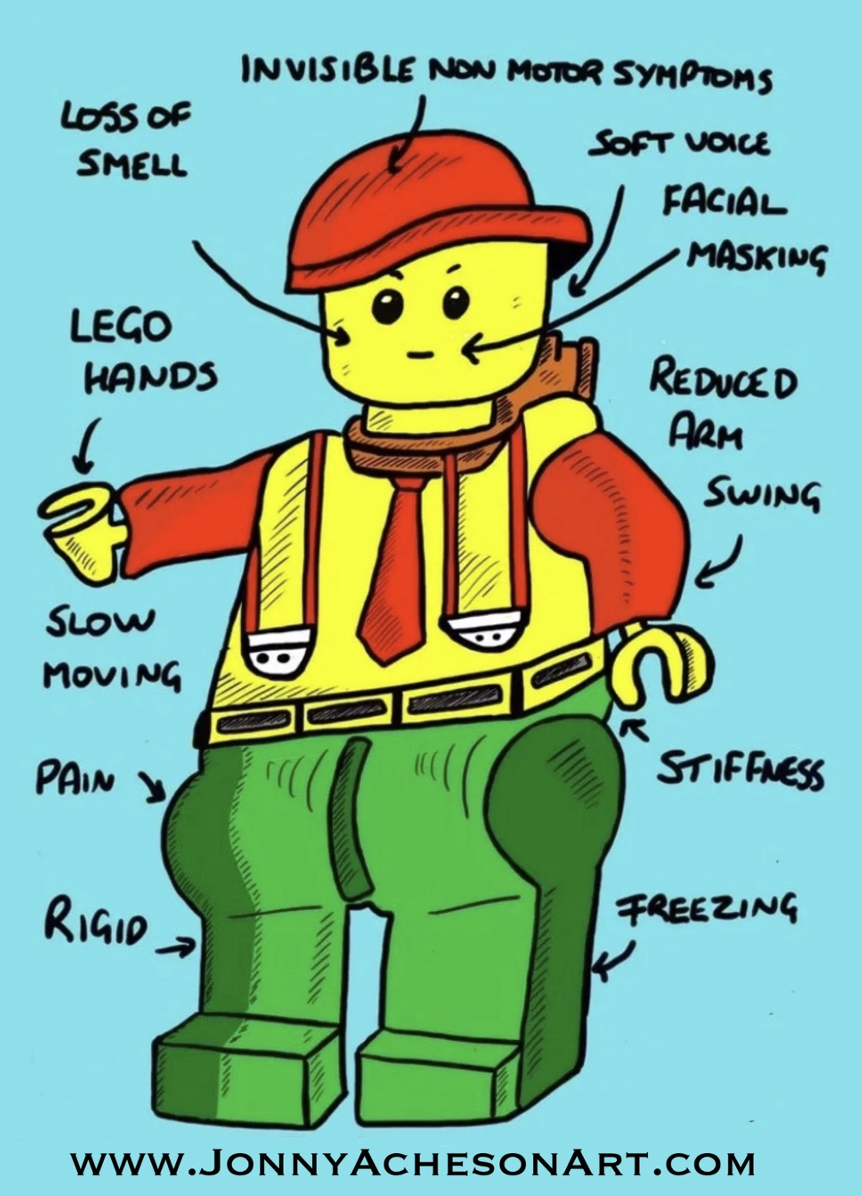How LEGO became a tool to teach Parkinson's: A father and daughter journey
Dr. Jonny Acheson is our awesome blog artist and also a doctor and Parkinson patient. We had the privilege of interviewing him about his experience using LEGO to explain Parkinson’s.
Dr. Jonny Acheson is an Emergency Medicine Doctor at University Hospitals of Leicester UK.
Jonny has been an Emergency Medicine Consultant in Leicester since 2009. His Postgraduate Emergency Medicine education work from 2012-2015 was recognised nationally with an HSJ award in 2016 and he was appointed as an Honorary Associate Professor in Medical Education the same year. Having been the Clinical Lead for Assessment at the University of Leicester Medical School he is now working with the GMC implementing the CPSA. Diagnosed with Parkinson’s in 2016 he strives to live as well as he can every day with a focus on exercise, diet and reducing stress. He took up art as a hobby again a few years ago and uses this to educate about Parkinson’s but also to draw people’s pets and children’s wall art. He is a co-author and artist for parkinsonsecrets.com blog.
Why LEGO and Parkinson’s disease
‘LEGO hands’ was not a phrase I had heard before, until I was in an online meeting one evening when someone who was living with Parkinson’s used it to describe what it felt like when they had started to lose dexterity and the fine motor skills in their hands.
They described the difficulty of picking small objects up from a table and getting their medications out of blister packs. They found that they were dropping things, only to pick them up and then drop them again; multiple times.
The LEGO Group was founded in 1932 by Ole Kirk Kristiansen. The company has passed from father to son and is now owned by Kjeld Kirk Kristiansen, a grandchild of the founder.
The word ‘LEGO’ is an abbreviation of the two Danish words “leg godt”, which means “play well.” There is an irony here which cannot be overlooked given the fact that in Parkinson’s the hands are not playing well or playing as well as they should.
Everyone I know has played with LEGO, if you have it in your house, you will find it everywhere from under the sofa, to under the seats in the car. Children are drawn to it, there is something innate in all of us that makes us want to make things. LEGO have a foundation whose aim is to build a future where learning through play empowers children to become creative, engaged, life-long learners.
This month the LEGO Foundation confirmed that it will be donating 600 LEGO® MRI Scanners to hospitals worldwide. It’s daunting enough having an MRI scan as an adult never mind a child but this initiative will help children prepare for it. If play is used then it will help the clinician, the radiographer, the parents and the child cope with the investigation. It is unclear whether the LEGO MRI scanner comes with added sound effects.
So, if LEGO can be used to educate children about having an MRI scan, could it be used to educate about other health conditions.
A few years ago, I was flying from Belfast in Northern Ireland back to Leicester in England with my family on New Year’s Eve. It was cold and wet and very busy. Going through an airport is one of the biggest dopamine burners there is— and I am always relieved to reach my seat.
As I checked that my daughter had her seat-beat on she reached across and checked I had mine on. With a confirmatory nod she then took the in-flight magazine out and started to flick through it. She stopped when she got to the back page as it had a LEGO figure on it. She looked at it for a few minutes and I could see that she was studying it hard.
She then looked up and started to explain why she thought this LEGO figure had Parkinson’s. He isn’t smiling and he doesn’t have a nose so that means that he must not be able to smell, just like you. LEGO men have stiff arms and legs and when you attach them to the board they don’t move, she was trying to describe freezing here.
So, we talked for a while and she asked a few more questions, her favourite being, do the doctors know what causes Parkinson’s yet?
On the drive back home that evening I couldn’t get that conversation out of my head, surely if a child can relate a LEGO figure to Parkinson’s maybe it can be used to educate other children about their parents or grandparents.
Over the next few days, I got my iPad out; opened Procreate and started to draw the LEGO figure that was on the back of that in-flight magazine. The result of which is shown below including the LEGO hands.
This was then adapted into a female LEGO figure. I formed a small woman’s focus group to brain storm some ideas about what we could incorporate. They were keen to get across that the LEGO figure should be young, dressed appropriately and they wanted to highlight the difficulty that they have putting on their make-up.
Although the LEGO Parkinson’s figures concentrated mainly on motor symptoms, the writing at the top did include invisible non motor symptoms, however these were not expanded on. That point gave me a further idea of using the LEGO figure again to educate around wearing off. So, after a few days of going over ideas in my head I sat down and sketched out what I thought was a fair representation of how if feels to wear off both motor and non-motor.
So once the sketches were complete, I had one final hurdle to jump over, I didn’t know how LEGO would react to the idea that their brand for children was being used to educate about Parkinson’s. I have to say I was nervous when I sent the email but they couldn’t have been nicer in their reply. So, it was full steam ahead on the education front.
A few weeks later I was invited in to my daughter’s primary school class to talk about Parkinson’s. Thirty children sat silently as I used these figures to attempted to explain what Parkinson’s was and how it felt to be living with it. After I had finished the first question came, then the next, and they kept coming. I have delivered many medical educational sessions in my career, but this was the toughest gig.
After that session I knew that the concept worked so I uploaded them onto my website along with other Parkinson’s colour figures https://jonnyachesonart.com/free-parkinson’s-figures initially I used them to raise funds for Parkinson’s charity but now they are free to download as digital JPEGs to be used for teaching under a Creative Commons license.
To read more books and articles by Michael S. Okun MD check on Twitter @MichaelOkun and these websites with blogs and information on his books and http://parkinsonsecrets.com/ #Livingwith Parkinson’s #EndingPD #Parkinsonsecrets #LessonsFromTheBedside
He also serves as the Medical Advisor for the Parkinson’s Foundation.
To see more on Dr. Indu Subramanian she does live interviews of experts in Parkinson’s for the PMD Alliance.
The blog artist is Jonny Acheson.










